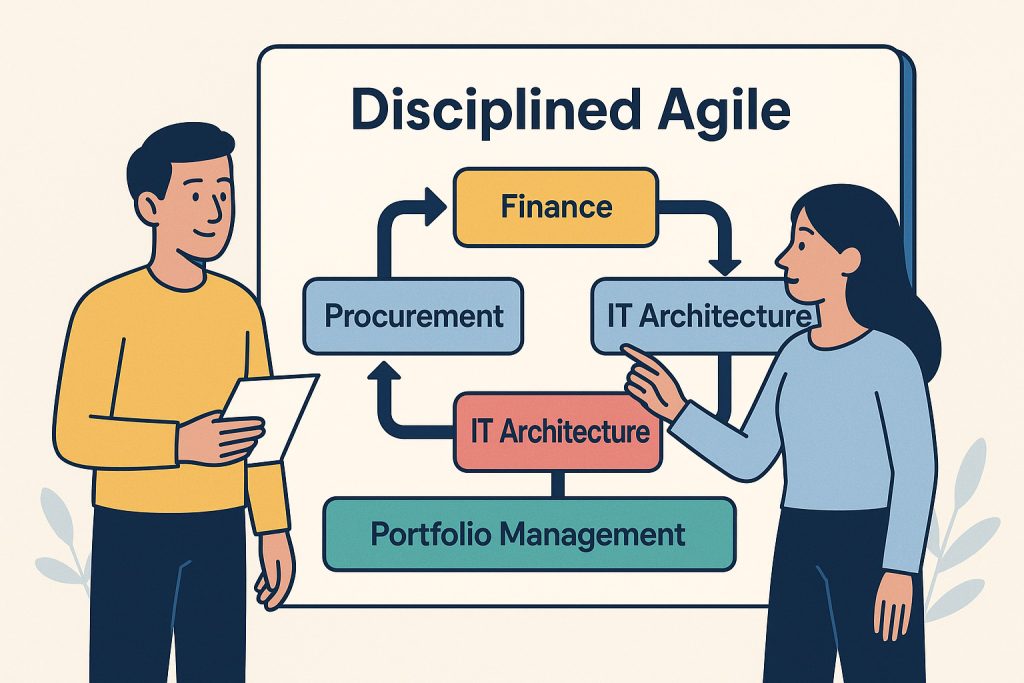In the ever-evolving landscape of project management methodologies, organizations constantly seek the perfect balance between structure and flexibility. While some teams thrive under the rigid ceremonies of Scrum or the flow-based approach of Kanban, others find themselves yearning for something that adapts more readily to their unique circumstances. Enter Disciplined Agile—a framework that deliberately refuses to prescribe a one-size-fits-all solution.
What is Disciplined Agile?
Disciplined Agile (DA) represents a fundamentally different approach to agile methodology. Rather than dictating specific practices and ceremonies, it operates as a process decision framework that emphasizes choice and context over conformity. The framework’s core philosophy centers on putting people first while providing lightweight guidance that helps teams craft their own optimal processes.
This people-centric approach shares DNA with the Crystal methodology family, recognizing that every team, project, and organization brings its own unique challenges and constraints. DA acknowledges what many experienced practitioners have long understood: the most effective processes are those that emerge from thoughtful consideration of specific circumstances rather than blind adherence to prescribed practices.
What makes DA particularly intriguing is its deliberate hybrid nature. The framework draws from the collective wisdom of established methodologies—incorporating elements from Extreme Programming’s technical practices, Scrum’s iterative approach, Kanban’s flow principles, and other proven frameworks. This synthesis creates a meta-framework that allows teams to cherry-pick the most suitable practices for their situation.
What is the History of Disciplined Agile?
The journey of Disciplined Agile began within IBM’s walls in 2009, though it didn’t reach public attention until 2012 with the publication of “Disciplined Agile Delivery.” This initial incarnation focused primarily on delivery processes, but the framework’s architects had grander ambitions. They recognized that true organizational agility extends far beyond software development teams.
As DA matured, specialized branches emerged to address different organizational domains. Disciplined DevOps tackled the integration of development and operations practices, while Disciplined Agile IT expanded the framework’s reach into broader technology management concerns. These extensions reflected a growing understanding that agile principles could enhance effectiveness across diverse organizational functions.
Today’s interpretation of Disciplined Agile has evolved into something much more comprehensive than its original scope. The framework now encompasses solution delivery in its broadest sense, reaching into traditionally non-agile domains such as finance, procurement, enterprise architecture, and portfolio management. This expansion reflects the reality that modern organizations require coherent approaches that span departmental boundaries rather than isolated pockets of agile practice.
What are the Framework’s Strengths and Weakness?
The strengths of Disciplined Agile stem directly from its philosophical foundation. Its hybrid approach allows organizations to leverage the collective learning embedded in multiple proven methodologies rather than betting everything on a single approach. This flexibility proves particularly valuable for complex environments where different parts of the organization face vastly different challenges.
DA’s strengths include:
- The hybrid nature pulls the best elements from several proven methodologies, creating a comprehensive toolkit rather than a narrow set of prescribed practices
- Teams can maintain agile principles while adapting their specific practices to match their unique context, reducing friction and increasing buy-in
However, this flexibility comes with inherent challenges. The framework’s strength—its lack of prescriptive guidance—simultaneously represents its primary weakness. Organizations new to agile methodologies often struggle with DA because it assumes a level of experience and judgment that inexperienced teams haven’t yet developed.
DA’s weaknesses include:
- The framework proves challenging for organizations new to agile, as it lacks the detailed guidance that inexperienced teams need to navigate their transformation successfully
- The abundance of choices and lack of prescriptive steps often necessitates external consulting support, adding cost and dependency to what should ideally be an empowering framework
The learning curve can prove particularly steep for teams accustomed to detailed process documentation and clear step-by-step guidance. Without sufficient experience to make informed process decisions, these teams may find themselves paralyzed by choice or, worse, making suboptimal decisions that undermine their agile transformation.
Should You Use Disciplined Agile?
The decision to adopt Disciplined Agile should align closely with an organization’s current agile maturity and specific needs. Teams with substantial agile experience often find DA’s flexibility liberating, allowing them to move beyond the constraints of single methodologies and craft truly optimized processes. These experienced practitioners can navigate the framework’s choices with confidence, drawing on their accumulated knowledge to make sound decisions.
Conversely, organizations in the early stages of agile adoption may find DA overwhelming rather than helpful. The framework’s emphasis on choice assumes teams possess the experience necessary to evaluate different approaches and understand their implications. Without this foundation, the abundance of options can create confusion and inconsistency rather than the intended optimization.
The context of the organization also matters significantly. Large enterprises with diverse business units may benefit from DA’s comprehensive scope, as it provides a common language and approach that can span different domains while still allowing for local adaptation. Smaller organizations with more focused needs might find simpler, more prescriptive frameworks better suited to their circumstances.
When examining Disciplined Agile in the broader context of agile methodologies, it becomes clear that no single framework serves all purposes equally well. DA fills a specific niche for mature organizations seeking to optimize their processes without abandoning agile principles. Its value lies not in providing easy answers but in offering a structured approach to asking the right questions about process design and organizational context. The framework’s emphasis on people over process reflects a deep understanding of what makes agile transformations succeed or fail, recognizing that technology and practices matter but that human elements ultimately determine outcomes.


